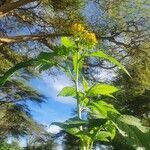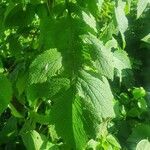Annual or short-lived perennial herb or soft-wooded shrub, erect or sometimes semi-scandent, rather weak-stemmed, 25–250 cm tall; stems green, sometimes tinged red towards the base, pubescent, glabrescent.. Leaves sessile, ovate, lanceolate, elliptic or obovate, unlobed to deeply and narrowly pinnately or pinnato-lyrately 2–8-lobed, 5.5–41 cm long, 1.5–22 cm wide, base rounded, cuneate or attenuate and slightly decurrent onto a petaloid base, margins closely sinuate-serrate to coarsely serrate-bidentate, apex acute to obtuse, often ± attenuate, almost glabrous to scattered-pubescent above and beneath especially on veins, ± glabrescent.. Capitula numerous in congested terminal corymbs, discoid; stalks of the individual capitula densely pubescent to glabrous; involucre cylindrical, 5.5–10.5 mm long, 2–4 mm in diameter in bud, to 6 mm at anthesis; bracts of calyculus 6–13, linear to lanceolate, 1.5–7 mm long, dark-tipped, glabrous or ciliate-margined; phyllaries 8–22, usually 13–15, green or yellow-green with dark brown or reddish tips, 5–9.5 mm long, glabrous or sparsely shortly pubescent.. Disc florets yellow or sometimes orange, corolla 5.5–9.5 mm long, tube glabrous, gradually expanded above the middle, lobes 0.5–1.5 mm long.. Achenes 1.7–2.5 mm long, ribbed, shortly sparsely hairy in the grooves; pappus 5–10 mm long.. Fig. 126 (page 603).
More
A herb. It grows 1.5 m tall. The leaves are alternate and oval to sword shaped. They are 9 cm long by 5 cm wide and they have teeth along the edge. The flowers are yellow and 1 cm long and 5-8 mm across.
Yellow florets in numerous heads usually less than 1/2 in. long
An erect much-branched herb up to about 4 ft. high



